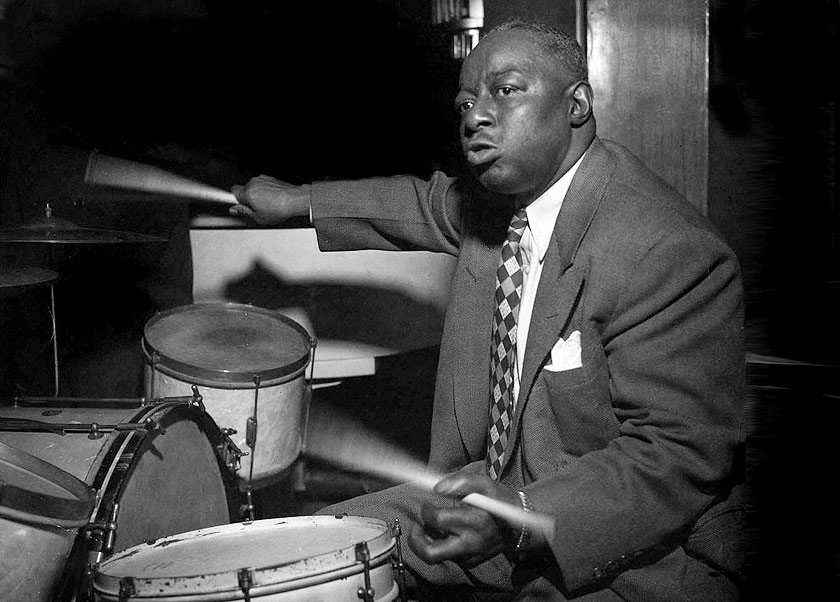
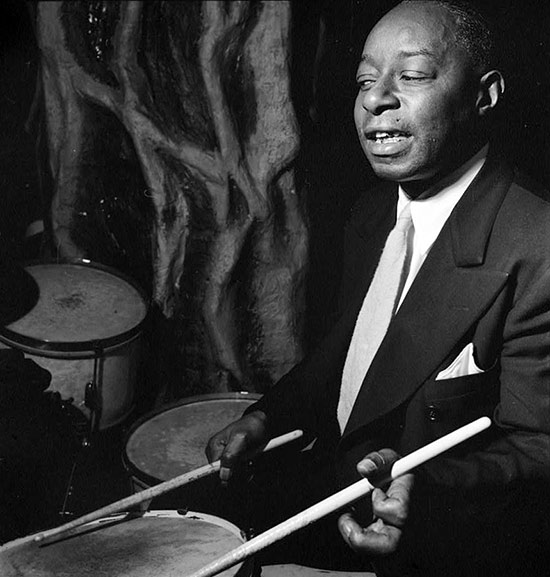
| Warren "Baby" Dodds |
|
Warren ‘Baby’ Dodds, born in 1897. Baby was the younger brother of
clarinettist, Johnny Dodds, one of most original and influential reedmen of those early
years.
Baby was a schooled drummer, which meant he had a thorough knowledge of the military rudiments of drumming. The difference, however, between Dodds and a conventional straight, parade drummer was his heritage. Dodds had Africa in his blood. His ancestors had been slaves and the rhythms of that exciting continent were, to a great degree, carried to new world. This tradition, mingled with European music, became what we know as Jazz. Dodds was playing in parades as early as the 1910s, often with Bunk Johnson as well as with "Frankie Dusen's Eagle Band". He played non parade gigs in the famous "Fewclothes Cabaret". A short spell with cornetist "Oscar Papa Celestin's Band" followed, before the young drummer joined Fate Marable's band on the SS Sydney. In 1921 he joined "Joe 'King' Oliver's Creole Jazz Band", with whom he made his first recordings in 1923. Featured in this all-star line-up was the 22 year-old cornet genius, Louis Armstrong. The sound of the Oliver band is merely hinted at on these acoustic recordings. Baby is hampered by the lack of a full drum kit, being restricted, for the most part, to playing the woodblock and a choke cymbal. Musicians who heard the band were struck by the big sound, attributable in no small measure to the Dodds rhythm. By 1927, Baby was playing in brother Johnny's band and can be heard with a full drum kit on recordings made by "Johnny Dodds his Black Bottom Stompers." "Come on and Stomp Stomp Stomp." These sessions from October 1927 were among the first recordings to feature a bass drum, which Baby plays in two-beat time. The two cornet line-up of this band was exactly the same as Oliver's, so it is not unreasonable to assume that this rhythm section sound was close to the real sound of Joe Oliver's band. Baby gets an early drum break in the middle of the trombone solo on "After You've Gone" Also at this time he found regular employment in the various Washboard bands. Baby's technique deserves some scrutiny. For the most part, the bass drum is playing two beats to the bar. Press rolls are played on the snare drum. This involves the left stick rolling across the drum with beats two and four accented. The right stick in most cases plays a steady four beats.Tthe roll starts on beat two and again on beat four. The tom toms are used for accents, as are the woodblocks, rims and cymbals. This is an oversimplification, because there was much more to Baby Dodds than this and I advise a close study of the CDs recommended below. On blocks, Baby would play a wide variety of beats incorporating flams, triplets, double stroke rolls, parradiddles and combinations of all these. The beat was a constantly moving thing and was generous in its width. White drummers such as Gene Krupa, and George Wettling, both Dodds disciples, were ‘on the beat’ players, whereas Dodds often played around the time, placing accents where they were least expected. Baby's blocks can be heard on Jelly Roll Morton's recording of "Billy Goat Stomp", which also has an early Dodds solo, played across a series of breaks. With Jelly, Dodds was required to play wire brushes and he is one of the first jazz drummers to be recorded with this lighter alternative to sticks. "Mr.Jelly Lord" provides a good example of Baby's brush style, which is merely and adaptation of his press roll, except that the brush is dragged across the snare drum, rather than rolled, with the other brush playing a steady four beats. A comparison to the work of Gene Krupa with the "Benny Goodman Trio" in the mid 30s indicates that Krupa got more than his stick technique from Dodds. The Depression years found the Dodds brothers struggling to earn a living from music with Baby forced to help his brother Bill run a taxi business. With the revival of interest in early New Orleans Jazz around 1940, Baby recorded for Decca as part of a New Orleans Album. Victor Records also took the opportunity of pairing him with the great New Orleans soprano saxophonist, Sidney Bechet for some memorable sides in 1941 This was a truly all-star lineup, completed by Earl Hines, piano, Rex Stewart, cornet and Welman Braud (another New Orleanian). Dodds can be head employing a wide variety of strokes and rolls, both in the ensembles and during his solo, which is played on the blocks, rims and cowbell. When Bill Russell rediscovered Bunk Johnson and recorded him in 1944, Baby was his chosen drummer. It is on these American Music recordings, made on less than perfect equipment by the devoted and enthusiastic Russell, that we hear Baby in all his glory. Baby Dodds is often regarded as being old fashioned and out of date, yet the late Art Blakey, one of the greats of modern Jazz drumming, often played Dodds fills with his forward looking hard bop group, the Jazz Messengers. Dodds remains one of the most creative and colourful drummers in the history of traditional Jazz and his paralysis from a stroke in the early 50s robbed the Jazz world of one of its great innovators. He died in 1959. |

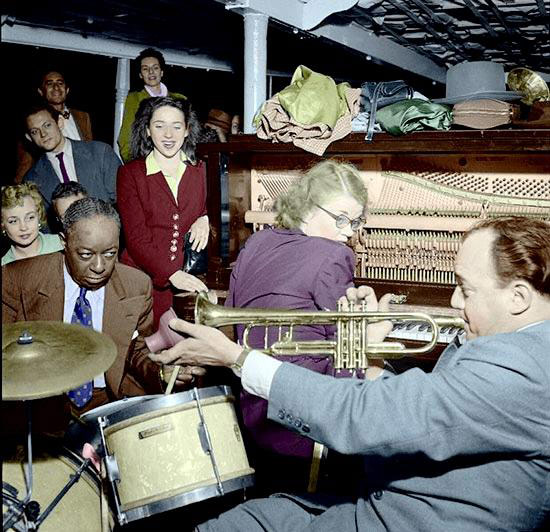 © Colored by Mike Creasy
© Colored by Mike Creasy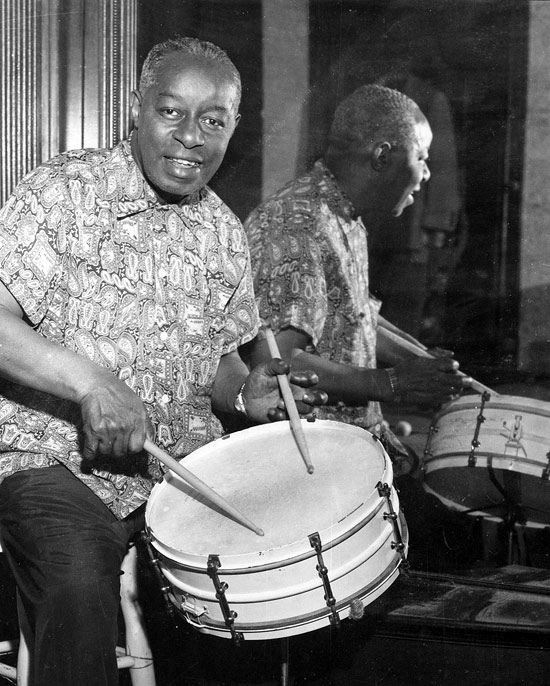
|
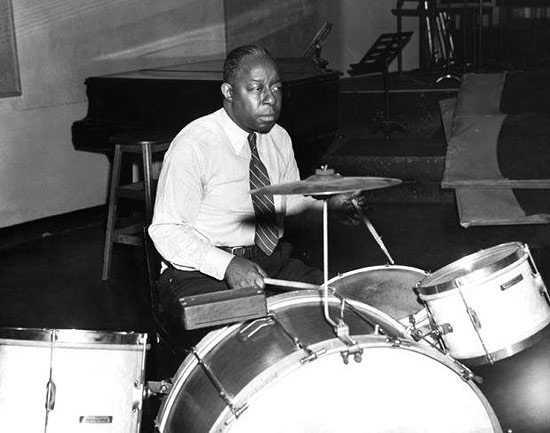
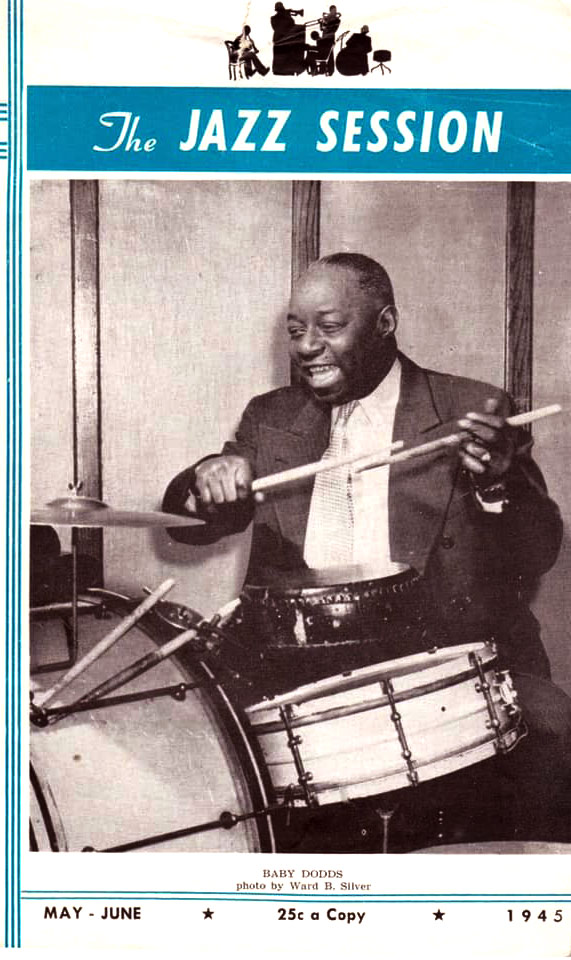

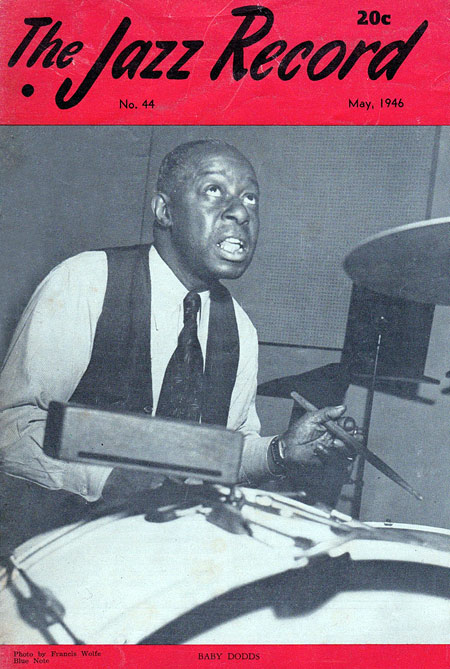
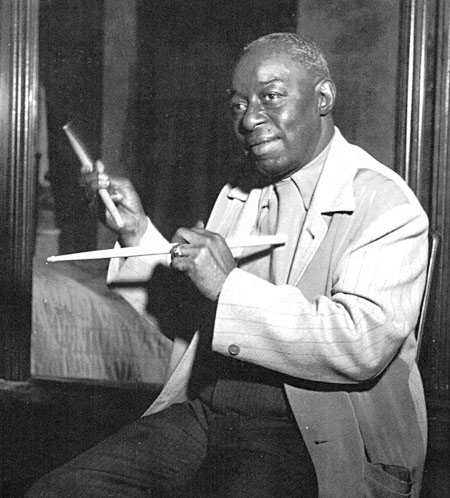
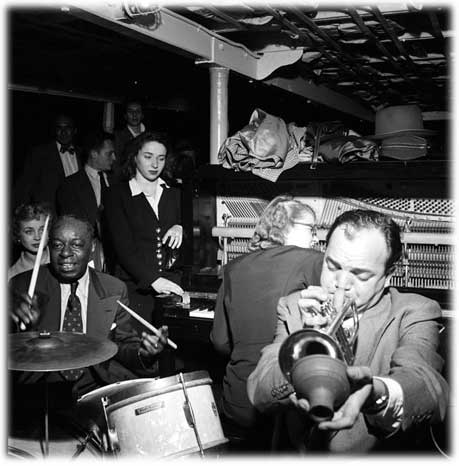 Baby Dodds with Marty Marsala and
Bunty Pendelton
Baby Dodds with Marty Marsala and
Bunty Pendelton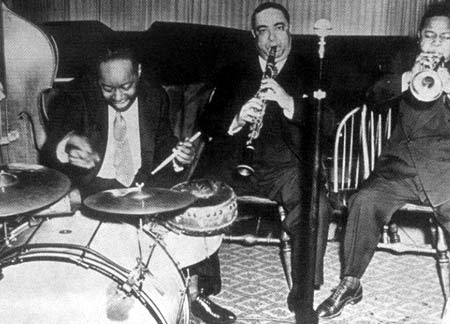 Baby Dodds ...jamming with Jimmy
Noone and Roy Eldridge
Baby Dodds ...jamming with Jimmy
Noone and Roy Eldridge at the 3 Deuces Chicago 1940

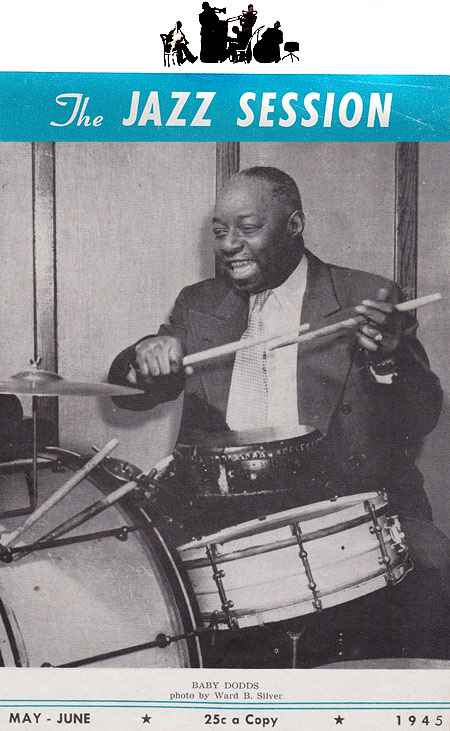
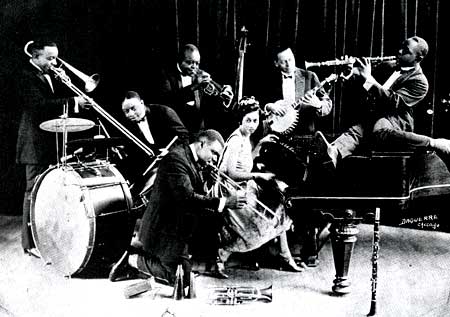 King Oliver's Creole Jazz
Band
King Oliver's Creole Jazz
Band- Honore Dutrey - Baby Dodds - King Oliver - Louis Armstrong -
- Lil Hardin-Armstrong - Bill Johnson - Johnny Dodds
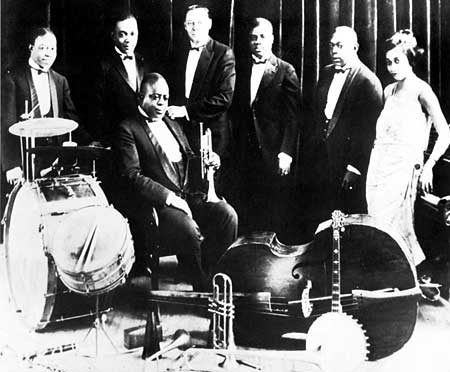 Baby Dodds, Honoré Dutrey, Bil
Johnson, Louis Armstrong, Johnny Dodds,
Baby Dodds, Honoré Dutrey, Bil
Johnson, Louis Armstrong, Johnny Dodds,Lil Hardin-Armstrong. Sitting in the foreground: King Oliver

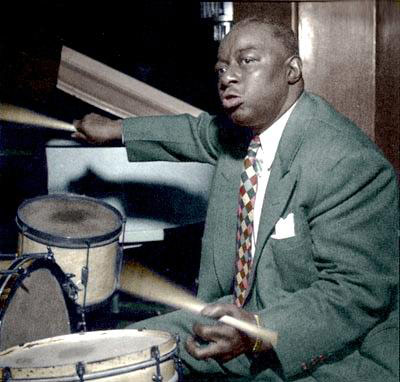
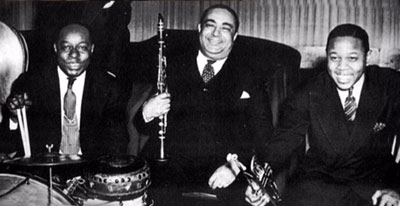
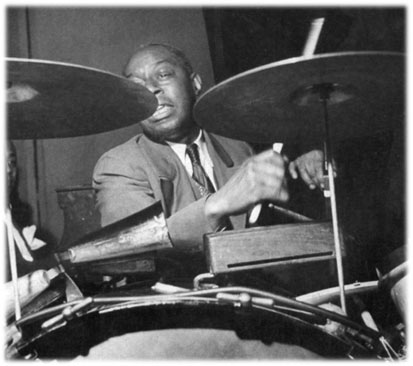
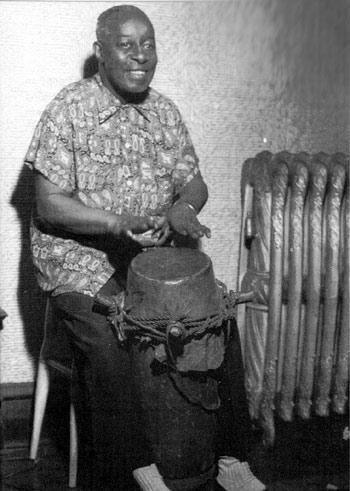 thanks for your visit!
thanks for your visit!
CLICK:
the 500 Top Drummers:
the 500 Top Drummers:



